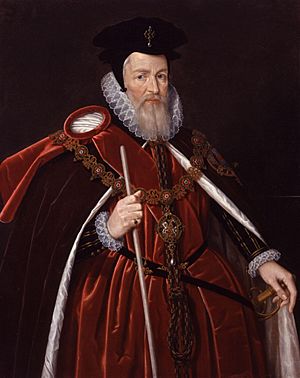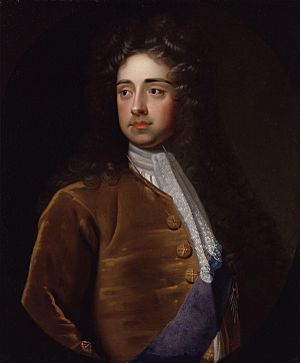Lord High Treasurer facts for kids
Quick facts for kids Lord High Treasurer of the United Kingdom |
|
|---|---|
|
Charles Talbot, 1st Duke of Shrewsbury, last holder of the office as Lord High Treasurer of Great Britain
|
|
| His Majesty's Treasury | |
| Appointer | The Monarch |
| Term length | At His Majesty's Pleasure |
| Precursor |
|
| Formation |
|
| First holder | Nigel of Ely as Lord High Treasurer of England |
| Final holder | Charles Talbot, 1st Duke of Shrewsbury as Lord High Treasurer of Great Britain |
The Lord High Treasurer was a very important job in the English government. After the Acts of Union of 1707, it became a British government position. This person was the third most important "Great Officer of State" in England. They were below the Lord High Steward and the Lord High Chancellor.
The Lord High Treasurer was in charge of the country's money, leading His Majesty's Treasury. The last person to hold this job by themselves was Charles Talbot, 1st Duke of Shrewsbury in 1714. Since then, no one has held the job alone.
Even though the United Kingdom of Great Britain and Ireland was formed in 1801, the jobs of Lord High Treasurer for Great Britain and for Ireland were not combined until 1817. This happened because of a law called the Consolidated Fund Act 1816.
This law also said that if there wasn't one single Lord High Treasurer, the King could choose a group of people to do the job. This group is called the Lords Commissioners of the Treasury. Today, this group usually includes the Prime Minister of the United Kingdom, who is often called the First Lord of the Treasury. The Chancellor of the Exchequer is usually the Second Lord of the Treasury. Other government members, often people who help manage votes in the House of Commons (called whips), also join this group.
What is the Lord High Treasurer?
The English Treasury, which handles the country's money, started around 1126. This was during the time of King Henry I. Before this, managing money was part of another job, the Lord Great Chamberlain. The Treasury was first a part of the King's own household. It kept the King's money safe.
In 1216, a Treasurer was chosen to look after the Treasury in Winchester. This Treasurer also worked for the Exchequer, which checked the royal accounts. By the 1500s, the job title "King's Treasurer" changed to "Lord High Treasurer."
During the time of the Tudors, the Lord High Treasurer became one of the most important government officials. They were ranked below the Lord Chancellor but above the Master of the Horse. It was even considered treason (a serious crime against the country) to kill them.

The Lord High Treasurer job was different from the Treasurer of the Exchequer. The Lord High Treasurer was given a white staff as a symbol of their appointment. The Treasurer of the Exchequer was appointed by special written orders from the King. However, if one person held the Treasury job, they usually held both titles.
When the job of Treasurer of the Exchequer is given to a group of people (called "put into commission"), the job of Lord High Treasurer is left empty.
In the 1500s, the Lord High Treasurer was often seen as the most powerful person in the government. They sometimes acted like a de facto Prime Minister, meaning they were the leader in practice, even if not by title. A great example is William Cecil, 1st Baron Burghley. He was Lord High Treasurer from 1572 to 1598. During his time, he was very influential in the government under Queen Elizabeth I.
Who Held the Job?
You can find a full list of people who held this important job here:
- List of lord high treasurers of England and Great Britain
See Also
- List of lords commissioners of the Treasury


